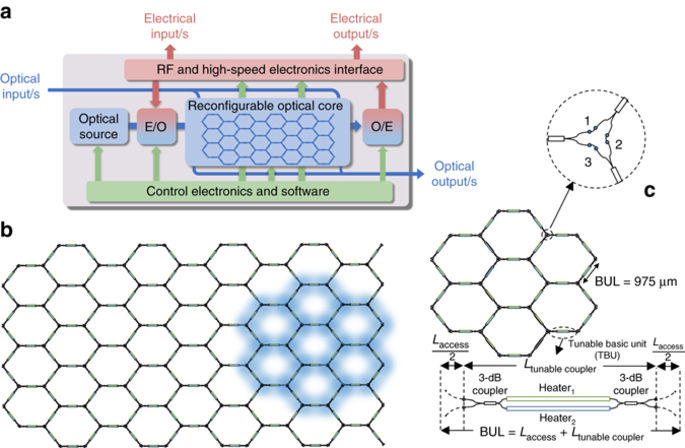当前位置:
X-MOL 学术
›
Nat. Commun.
›
论文详情
Our official English website, www.x-mol.net, welcomes your
feedback! (Note: you will need to create a separate account there.)
Multipurpose silicon photonics signal processor core.
Nature Communications ( IF 14.7 ) Pub Date : 2017-09-21 , DOI: 10.1038/s41467-017-00714-1 Daniel Pérez , Ivana Gasulla , Lee Crudgington , David J. Thomson , Ali Z. Khokhar , Ke Li , Wei Cao , Goran Z. Mashanovich , José Capmany
Nature Communications ( IF 14.7 ) Pub Date : 2017-09-21 , DOI: 10.1038/s41467-017-00714-1 Daniel Pérez , Ivana Gasulla , Lee Crudgington , David J. Thomson , Ali Z. Khokhar , Ke Li , Wei Cao , Goran Z. Mashanovich , José Capmany

|
Integrated photonics changes the scaling laws of information and communication systems offering architectural choices that combine photonics with electronics to optimize performance, power, footprint, and cost. Application-specific photonic integrated circuits, where particular circuits/chips are designed to optimally perform particular functionalities, require a considerable number of design and fabrication iterations leading to long development times. A different approach inspired by electronic Field Programmable Gate Arrays is the programmable photonic processor, where a common hardware implemented by a two-dimensional photonic waveguide mesh realizes different functionalities through programming. Here, we report the demonstration of such reconfigurable waveguide mesh in silicon. We demonstrate over 20 different functionalities with a simple seven hexagonal cell structure, which can be applied to different fields including communications, chemical and biomedical sensing, signal processing, multiprocessor networks, and quantum information systems. Our work is an important step toward this paradigm.Integrated optical circuits today are typically designed for a few special functionalities and require complex design and development procedures. Here, the authors demonstrate a reconfigurable but simple silicon waveguide mesh with different functionalities.
中文翻译:

多功能硅光子信号处理器内核。
集成式光子学改变了信息和通信系统的缩放定律,提供了架构选择,将光子学与电子学结合起来可以优化性能,功耗,占地面积和成本。专用光子集成电路(其中特定电路/芯片被设计为以最佳方式执行特定功能)需要大量设计和制造迭代,从而需要较长的开发时间。受电子现场可编程门阵列启发的另一种方法是可编程光子处理器,其中由二维光子波导网格实现的通用硬件通过编程实现了不同的功能。在这里,我们报告了这种可重构波导网格在硅中的演示。我们用一个简单的七边形六边形单元结构演示了20多种不同的功能,这些结构可以应用于不同的领域,包括通信,化学和生物医学传感,信号处理,多处理器网络和量子信息系统。我们的工作是朝着这一范例迈出的重要一步。如今,集成光电路通常是为一些特殊功能而设计的,并且需要复杂的设计和开发程序。在这里,作者演示了具有不同功能的可重构但简单的硅波导网。当今的集成光学电路通常被设计用于一些特殊功能,并且需要复杂的设计和开发程序。在这里,作者演示了具有不同功能的可重构但简单的硅波导网。当今的集成光学电路通常被设计用于一些特殊功能,并且需要复杂的设计和开发程序。在这里,作者演示了具有不同功能的可重构但简单的硅波导网。
更新日期:2017-09-21
中文翻译:

多功能硅光子信号处理器内核。
集成式光子学改变了信息和通信系统的缩放定律,提供了架构选择,将光子学与电子学结合起来可以优化性能,功耗,占地面积和成本。专用光子集成电路(其中特定电路/芯片被设计为以最佳方式执行特定功能)需要大量设计和制造迭代,从而需要较长的开发时间。受电子现场可编程门阵列启发的另一种方法是可编程光子处理器,其中由二维光子波导网格实现的通用硬件通过编程实现了不同的功能。在这里,我们报告了这种可重构波导网格在硅中的演示。我们用一个简单的七边形六边形单元结构演示了20多种不同的功能,这些结构可以应用于不同的领域,包括通信,化学和生物医学传感,信号处理,多处理器网络和量子信息系统。我们的工作是朝着这一范例迈出的重要一步。如今,集成光电路通常是为一些特殊功能而设计的,并且需要复杂的设计和开发程序。在这里,作者演示了具有不同功能的可重构但简单的硅波导网。当今的集成光学电路通常被设计用于一些特殊功能,并且需要复杂的设计和开发程序。在这里,作者演示了具有不同功能的可重构但简单的硅波导网。当今的集成光学电路通常被设计用于一些特殊功能,并且需要复杂的设计和开发程序。在这里,作者演示了具有不同功能的可重构但简单的硅波导网。


















































 京公网安备 11010802027423号
京公网安备 11010802027423号